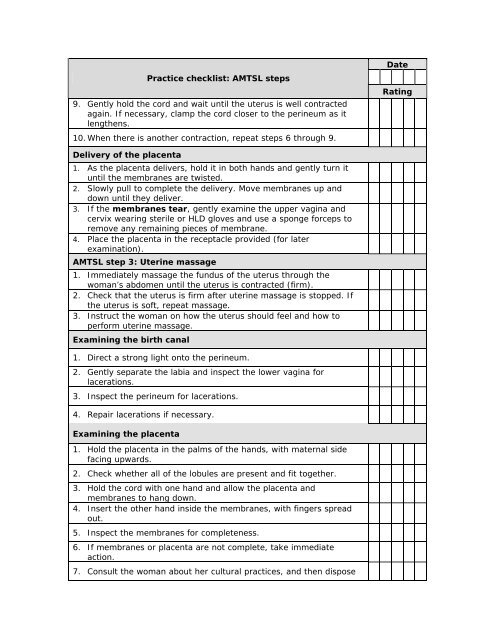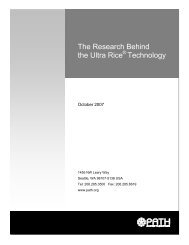Skills Checklist - Path
Skills Checklist - Path
Skills Checklist - Path
You also want an ePaper? Increase the reach of your titles
YUMPU automatically turns print PDFs into web optimized ePapers that Google loves.
Practice checklist: AMTSL steps<br />
9. Gently hold the cord and wait until the uterus is well contracted<br />
again. If necessary, clamp the cord closer to the perineum as it<br />
lengthens.<br />
10. When there is another contraction, repeat steps 6 through 9.<br />
Date<br />
Rating<br />
Delivery of the placenta<br />
1. As the placenta delivers, hold it in both hands and gently turn it<br />
until the membranes are twisted.<br />
2. Slowly pull to complete the delivery. Move membranes up and<br />
down until they deliver.<br />
3. If the membranes tear, gently examine the upper vagina and<br />
cervix wearing sterile or HLD gloves and use a sponge forceps to<br />
remove any remaining pieces of membrane.<br />
4. Place the placenta in the receptacle provided (for later<br />
examination).<br />
AMTSL step 3: Uterine massage<br />
1. Immediately massage the fundus of the uterus through the<br />
woman’s abdomen until the uterus is contracted (firm).<br />
2. Check that the uterus is firm after uterine massage is stopped. If<br />
the uterus is soft, repeat massage.<br />
3. Instruct the woman on how the uterus should feel and how to<br />
perform uterine massage.<br />
Examining the birth canal<br />
1. Direct a strong light onto the perineum.<br />
2. Gently separate the labia and inspect the lower vagina for<br />
lacerations.<br />
3. Inspect the perineum for lacerations.<br />
4. Repair lacerations if necessary.<br />
Examining the placenta<br />
1. Hold the placenta in the palms of the hands, with maternal side<br />
facing upwards.<br />
2. Check whether all of the lobules are present and fit together.<br />
3. Hold the cord with one hand and allow the placenta and<br />
membranes to hang down.<br />
4. Insert the other hand inside the membranes, with fingers spread<br />
out.<br />
5. Inspect the membranes for completeness.<br />
6. If membranes or placenta are not complete, take immediate<br />
action.<br />
7. Consult the woman about her cultural practices, and then dispose
















